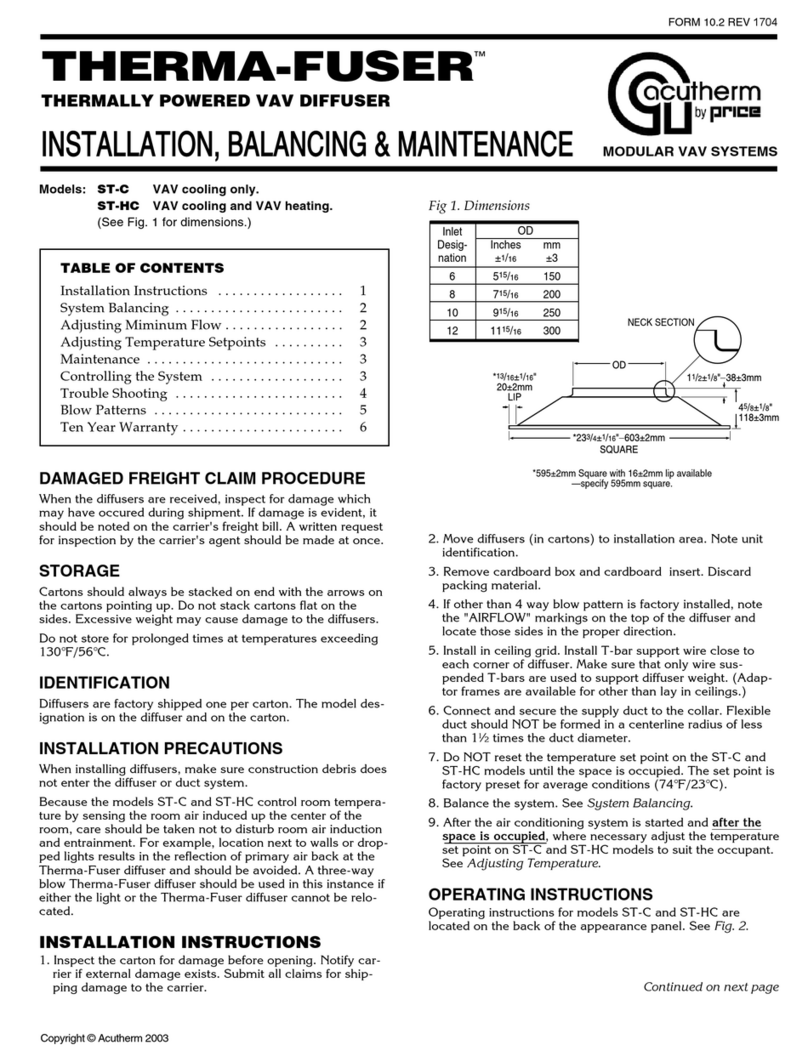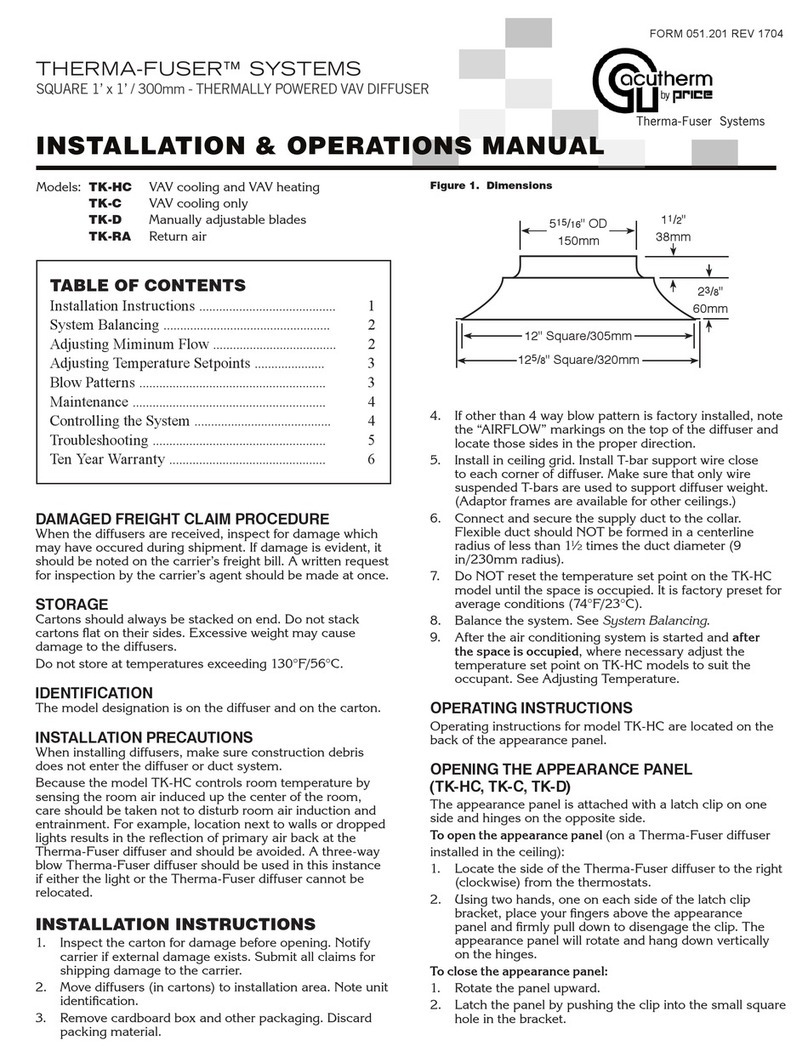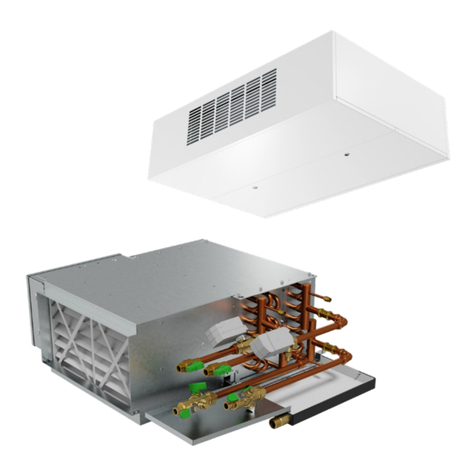
3
acutherm.com | THERMA-FUSER™ - Manual
THERMA-FUSER™
VAV systems are balanced for design air volume at maximum air flow and systems using Therma-Fuser VAV diffusers are no
exception. When all the Therma-Fuser diffusers are set for maximum air flow by fully opening them, the system is really a constant
air volume system and is balanced as a constant volume system. Balancing dampers are best located at the takeoff before the
runout to the Therma-Fuser diffuser.
1. Prepare the system for balancing. (Make necessary
checks for diversity, fan capacities, fan rotation, miminum
outside air requirements, duct leaks and static pressure
controller design settings. Set outside air control damper
for minimum air and return air control damper for
maximum air.)
2. Make sure Therma-Fuser diffusers are open. TL-C and TL-
CW models are shipped with balancing stops in position
to hold the blade(s) wide open. The stops are a wedge
which should be wedged between the foam side of the
blade and the curved aluminum piece (pushing the blade
so that its back is in contact with the vertical aluminum
piece). See Fig. 5. For multiple blade units, all blades must
be wedged open for proper balancing.
3. Start fans, adjust system for 100% air flow and make
system checks. (Measure static pressure across filters and
coils and at sensor for static pressure controller. Measure
supply, return and branch duct air flow.)
4. Measure air flow from each Therma-Fuser diffuser and
adjust damper at the duct takeoff to obtain design air
volume. Air volume measurement may be made with a
direct reading balancing hood or air velocity meter. If a
velocity meter is used, the velocity is measured in the
outside slot on the same side as the duct connection 2
in. / 51mm from either end of the blade at the opening
between the outside blades and the curved aluminum
piece. See Fig. 6. The Akfactors for the different linear
lengths are shown in Table 1. Multiply the velocity in fpm
times Akin ft2to get air flow in cfm.
5. Return Therma-Fuser diffusers to operating condition.
Remove balancing stops by grabbing the looped end and
pulling straight down from the face.
6. Return the remainder of the system to operating condition.
Table 1. Akfactors in ft.² for TL Therma-Fuser diffusers
fully open.
Type AkType AkType Ak
TL-2411
TL-3611
TL-4811
TL-6011
0.07
0.11
0.14
0.22
TL-2422
TL-3622
TL-4822
TL-6022
0.14
0.18
0.26
0.28
TL-2421
TL-3621
TL-4821
TL-6021
0.12
0.20
0.28
0.32
TL-2411
TL-3641
TL-4841
TL-6041
0.31
0.42
0.60
0.70
TL-2422
TL-3642
TL-4842
TL-6042
0.30
0.39
0.55
0.65
BALANCING (TL-D)
1. The damper blade opening is factory set. Readjust where
necessary by turning the adjusting screw. See Fig. 7.
2. Place a direct reading diffuser balancing hood over the
face of each TL-D diffuser
SYSTEM BALANCING
FIG. 4 END ANGLE RAISED SO THAT LONGITUDINAL EDGES ARE IN THE
PLANE OF THE T-BARS
Page 3
Continued on NEXT Page
Type Ak Type Ak Type Ak
TL-2411 .07 TL-2422 .14 TL-2421 .12
TL-3611 .11 TL-3622 .18 TL-3621 .20
TL-4811 .14 TL-4822 .26 TL-4821 .28
TL-6011 .22 TL-6022 .28 TL-6021 .32
TL-2441 .31 TL-2442 .30
TL-3641 .42 TL-3642 .39
TL-4841 .60 TL-4842 .55
TL-6041 .70 TL-6042 .65
Fig 5. Balancing Stops
Fig 4. End angle raised so that longitudinal edges
are in the plane of the T-bars.
Table 1. Akfactors in ft.² for TL Therma-Fuser
diffusers fully open.
Screws
T-bar
End Angle Longitudinal edge in the same plane
as the bottom of the T-bar.
Diffuser
BALANCING (TL-D)
1. The damper blade opening is factory set. Readjust where nec-
essary by turning the adjusting screw. See Fig. 7.
2. Place a direct reading diffuser balancing hood over the face of
each TL-D diffuser and adjust damper at duct takeoff to obtain
design air volume.
Balancing Stop
SYSTEM BALANCING (TL-C and TL-CW)
VAV systems are balanced for design air volume at maximum air
flow and systems using Therma-Fuser VAV diffusers are no
exception. When all the Therma-Fuser diffusers are set for maxi-
mum air flow by fully opening them, the system is really a con-
stant air volume system and is balanced as a constant volume
system. Balancing dampers are best located at the takeoff before
the runout to the Therma-Fuser diffuser.
1. Prepare the system for balancing. (Make necessary checks for
diversity, fan capacities, fan rotation, miminum outside air
requirements, duct leaks and static pressure controller design
settings. Set outside air control damper for minimum air and
return air control damper for maximum air.)
2. Make sure Therma-Fuser diffusers are open. TL-C and TL-CW
models are shipped with balancing stops in position to hold
the blade(s) wide open. The stops are a wedge which should
be wedged between the foam side of the blade and the curved
aluminum piece (pushing the blade so that its back is in con-
tact with the vertical aluminum piece). See Fig. 5. For multiple
blade units, all blades must be wedged open for proper bal-
ancing.
3. Start fans, adjust system for 100% air flow and make system
checks. (Measure static pressure across filters and coils and at
sensor for static pressure controller. Measure supply, return
and branch duct air flow.)
4. Measure air flow from each Therma-Fuser diffuser and adjust
damper at the duct takeoff to obtain design air volume. Air
volume measurement may be made with a direct reading bal-
ancing hood or air velocity meter. If a velocity meter is used,
the velocity is measured in the outside slot on the same side
as the duct connection 2 in. / 51mm from either end of the
blade at the opening between the outside blades and the
curved aluminum piece. See Fig. 6. The Akfactors for the dif-
ferent linear lengths are shown in Table 1. Multiply the velocity
in fpm times Akin ft2to get air flow in cfm.
5. Return Therma-Fuser diffusers to operating condition. Remove
balancing stops by grabbing the looped end and pulling
straight down from the face.
6. Return the remainder of the system to operating condition.
Figure 6. Location of Velometer
Probe
Velometer
1250 to
2300 fpm
Measure in the outside slots
on the same side as the duct
connection 2 In. / 51mm from
either end of the blade.
FIG. 5 BALANCING STOPS
Page 3
Continued on NEXT Page
Type Ak Type Ak Type Ak
TL-2411 .07 TL-2422 .14 TL-2421 .12
TL-3611 .11 TL-3622 .18 TL-3621 .20
TL-4811 .14 TL-4822 .26 TL-4821 .28
TL-6011 .22 TL-6022 .28 TL-6021 .32
TL-2441 .31 TL-2442 .30
TL-3641 .42 TL-3642 .39
TL-4841 .60 TL-4842 .55
TL-6041 .70 TL-6042 .65
Fig 5. Balancing Stops
Fig 4. End angle raised so that longitudinal edges
are in the plane of the T-bars.
Table 1. Akfactors in ft.² for TL Therma-Fuser
diffusers fully open.
Screws
T-bar
End Angle Longitudinal edge in the same plane
as the bottom of the T-bar.
Diffuser
BALANCING (TL-D)
1. The damper blade opening is factory set. Readjust where nec-
essary by turning the adjusting screw. See Fig. 7.
2. Place a direct reading diffuser balancing hood over the face of
each TL-D diffuser and adjust damper at duct takeoff to obtain
design air volume.
Balancing Stop
SYSTEM BALANCING (TL-C and TL-CW)
VAV systems are balanced for design air volume at maximum air
flow and systems using Therma-Fuser VAV diffusers are no
exception. When all the Therma-Fuser diffusers are set for maxi-
mum air flow by fully opening them, the system is really a con-
stant air volume system and is balanced as a constant volume
system. Balancing dampers are best located at the takeoff before
the runout to the Therma-Fuser diffuser.
1. Prepare the system for balancing. (Make necessary checks for
diversity, fan capacities, fan rotation, miminum outside air
requirements, duct leaks and static pressure controller design
settings. Set outside air control damper for minimum air and
return air control damper for maximum air.)
2. Make sure Therma-Fuser diffusers are open. TL-C and TL-CW
models are shipped with balancing stops in position to hold
the blade(s) wide open. The stops are a wedge which should
be wedged between the foam side of the blade and the curved
aluminum piece (pushing the blade so that its back is in con-
tact with the vertical aluminum piece). See Fig. 5. For multiple
blade units, all blades must be wedged open for proper bal-
ancing.
3. Start fans, adjust system for 100% air flow and make system
checks. (Measure static pressure across filters and coils and at
sensor for static pressure controller. Measure supply, return
and branch duct air flow.)
4. Measure air flow from each Therma-Fuser diffuser and adjust
damper at the duct takeoff to obtain design air volume. Air
volume measurement may be made with a direct reading bal-
ancing hood or air velocity meter. If a velocity meter is used,
the velocity is measured in the outside slot on the same side
as the duct connection 2 in. / 51mm from either end of the
blade at the opening between the outside blades and the
curved aluminum piece. See Fig. 6. The Akfactors for the dif-
ferent linear lengths are shown in Table 1. Multiply the velocity
in fpm times Akin ft2to get air flow in cfm.
5. Return Therma-Fuser diffusers to operating condition. Remove
balancing stops by grabbing the looped end and pulling
straight down from the face.
6. Return the remainder of the system to operating condition.
Figure 6. Location of Velometer
Probe
Velometer
1250 to
2300 fpm
Measure in the outside slots
on the same side as the duct
connection 2 In. / 51mm from
either end of the blade.
FIG. 6 LOCATION OF VELOMETER
Page 3
Continued on NEXT Page
Type Ak Type Ak Type Ak
TL-2411 .07 TL-2422 .14 TL-2421 .12
TL-3611 .11 TL-3622 .18 TL-3621 .20
TL-4811 .14 TL-4822 .26 TL-4821 .28
TL-6011 .22 TL-6022 .28 TL-6021 .32
TL-2441 .31 TL-2442 .30
TL-3641 .42 TL-3642 .39
TL-4841 .60 TL-4842 .55
TL-6041 .70 TL-6042 .65
Fig 5. Balancing Stops
Fig 4. End angle raised so that longitudinal edges
are in the plane of the T-bars.
Table 1. Akfactors in ft.² for TL Therma-Fuser
diffusers fully open.
Screws
T-bar
End Angle Longitudinal edge in the same plane
as the bottom of the T-bar.
Diffuser
BALANCING (TL-D)
1. The damper blade opening is factory set. Readjust where nec-
essary by turning the adjusting screw. See Fig. 7.
2. Place a direct reading diffuser balancing hood over the face of
each TL-D diffuser and adjust damper at duct takeoff to obtain
design air volume.
Balancing Stop
SYSTEM BALANCING (TL-C and TL-CW)
VAV systems are balanced for design air volume at maximum air
flow and systems using Therma-Fuser VAV diffusers are no
exception. When all the Therma-Fuser diffusers are set for maxi-
mum air flow by fully opening them, the system is really a con-
stant air volume system and is balanced as a constant volume
system. Balancing dampers are best located at the takeoff before
the runout to the Therma-Fuser diffuser.
1. Prepare the system for balancing. (Make necessary checks for
diversity, fan capacities, fan rotation, miminum outside air
requirements, duct leaks and static pressure controller design
settings. Set outside air control damper for minimum air and
return air control damper for maximum air.)
2. Make sure Therma-Fuser diffusers are open. TL-C and TL-CW
models are shipped with balancing stops in position to hold
the blade(s) wide open. The stops are a wedge which should
be wedged between the foam side of the blade and the curved
aluminum piece (pushing the blade so that its back is in con-
tact with the vertical aluminum piece). See Fig. 5. For multiple
blade units, all blades must be wedged open for proper bal-
ancing.
3. Start fans, adjust system for 100% air flow and make system
checks. (Measure static pressure across filters and coils and at
sensor for static pressure controller. Measure supply, return
and branch duct air flow.)
4. Measure air flow from each Therma-Fuser diffuser and adjust
damper at the duct takeoff to obtain design air volume. Air
volume measurement may be made with a direct reading bal-
ancing hood or air velocity meter. If a velocity meter is used,
the velocity is measured in the outside slot on the same side
as the duct connection 2 in. / 51mm from either end of the
blade at the opening between the outside blades and the
curved aluminum piece. See Fig. 6. The Akfactors for the dif-
ferent linear lengths are shown in Table 1. Multiply the velocity
in fpm times Akin ft2to get air flow in cfm.
5. Return Therma-Fuser diffusers to operating condition. Remove
balancing stops by grabbing the looped end and pulling
straight down from the face.
6. Return the remainder of the system to operating condition.
Figure 6. Location of Velometer
Probe
Velometer
1250 to
2300 fpm
Measure in the outside slots
on the same side as the duct
connection 2 In. / 51mm from
either end of the blade.






































